BY STEVE JOHNSON ()
Today's bike radios can fit into the palm of your hand. Some will play your digital music collection. Others may even have built-in GPS giving you maps, location, speed, direction, altitude, and more, but this was not always the case.
Bicycles predated consumer radios by at least 50 years, but as soon as radios and their battery cases became almost physically small enough to mount on a bicycle many attempts were made to do just that. A few of these early attempts were even documented. These first attempts at adding a radio to a bicycle were quite elaborate and time consuming. Finding space and ways to mount a large tube radio along with its long antenna and heavy battery pack was quite a task in the early days of radio.
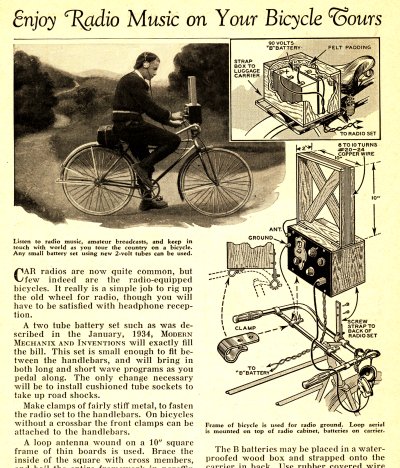
Diagram showing how to mount an early radio on a bicycle (1934).
The magazine article above from 1934 details mounting a early vacuum tube radio along with its batteries on a bicycle and instructions for constructing and mounting a loop antenna on top of the radio. Notice the radio chosen is not powerful enough to power a speaker. Headphones would need to be worn by the rider. Although attempts were made to mount standard home radios of the time on bicycles, it wouldn't be until just before World War II that radios designed specifically for bicycles would appear in radio stores and bicycle shops.
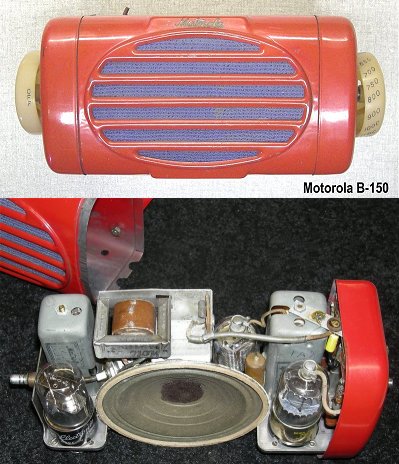
The Motorola B-150 vacuum tube bicycle radio.
In the late 1930s, Motorola was building radios that could be mounted on a policeman's bicycle. These were tuned specifically for picking up broadcasts on a single predetermined police frequency. Due to success of their police band radio, Motorola expanded on the design and in 1939 introduced the model B-150 bicycle radio. The B-150 could tune in the entire broadcast band (AM) and was aimed at consumers. Most were sold through bicycle shops.
The Motorola B-150 contained three vacuum tubes and ran off a separate battery pack. The radio itself was mounted on the bicycles handlebars. The radio's battery pack was designed to clamp to the down tube of the bicycle and the radio's whip antenna could be bent forward from the radio and clipped to the front fender. The Motorola B-150 was bright red with blue a speaker grill cloth.
Today an original Motorola B-150 is popular with radio and bicycle collectors and ranges in price anywhere from $100 to well over $400 depending on condition. As with any vintage radio, some restoration would be needed to replace capacitors and other out-of-spec components before trying to operate it.
After World War II the vacuum tube bicycle radios manufactured offered smaller battery packs or had the batteries installed inside the radio case.
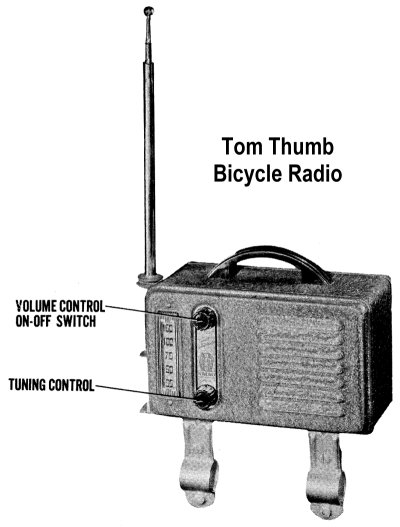
The Tom Thumb Bicycle Radio had internal batteries.
The Tom Thumb bicycle radio was manufactured in 1949 by the Automatic Radio Manufacturing Co. of Boston, MA. This smaller AM radio contained four vacuum tubes. It was powered by two 1.5-V and one 67.5-V battery housed inside the case itself. Gone were the large internal battery packs that had to be mounted separately.
The Tom Thumb is a popular radio among both bicycle and radio collectors. Bicycles from the 1950s are very popular with collectors and any bicycle radio in good condition from that era commands top dollar. The Tom Thumb bicycle radio is scarce and would easily range from $150 to $550. One is seldom found with its original mounting brackets and unfortunately, the original paint had a tendency to flake off. Expect any 1949 Tom Thumb bicycle radio with its original brackets and original paint still intact to be valued at the highest end of the scale. Working condition in this case is unimportant.
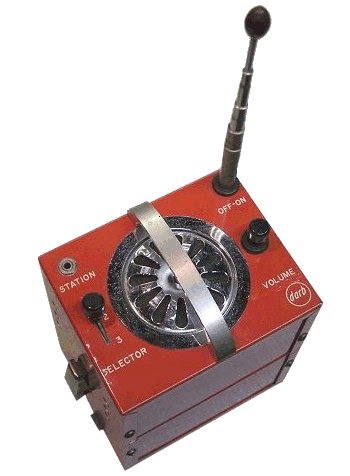
The Darb Holiday Bicycle radio.
The Darb Holiday Bicycle radio was manufactured in the mid 1950s by the S. C. Ryan Co. of Minneapolis, MN. The Darb was available in at least three colors, red, blue, and green. It came with a detachable battery pack that clipped to the bottom of the radio or as an option, used a set of pre wired brackets that allowed the radio section to mount on the handlebars and the battery pack on the rear carrier. There was also an AC power supply available to replace the battery pack so the radio could unclipped from the bicycle and used indoors.
The Darb radio only picked up three stations at a time. It was equipped with a three position station selector on the top. There were two sets of three tuning screws on the side of the radio. Using a small screwdriver, you tuned in a station on the left row and then tuned the antenna for maximum volume using the tuning screw to the right.
The Darb had a combination on/off volume control on the right side. There was also an output connector on the top for headphone listening and an optional antenna adapter that could replace the extendable antenna for hooking up a longer antenna wire. It used four vacuum tubes that actually mounted upside down inside the case. There does not appear to be anything to prevent them from eventually vibrating loose from the tube sockets.
The Darb used some common hardware in its construction. The case was made from standard project boxes available through most electronic suppliers of the time. The handle was a standard cabinet handle available at most hardware stores and you might see the Darb speaker grill covering the drain in your tub.
The Darb Holiday Radio was a popular addition to a bicycle in the 1950s and many have survived. Today a Darb bicycle radio in good cosmetic condition and complete with the mounting brackets may sometimes be found in the $150 to $200 range.
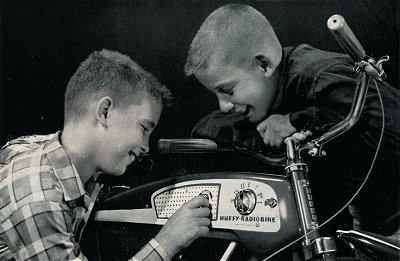
The Huffy Radio Bike — The ultimate bicycle radio.
The Huffy Radio Bike with its built-in radio was manufactured in 1955 and 1956 by the Huffman Manufacturing Co. of Dayton, OH. Around 8,500 bicycles were produced. They were available in Flamboyant Red with white and black trim, Flamboyant Blue, and Flamboyant Green. The red radio bikes seem to have been the prominent survivors. My guess is that red was the most popular color and more were produced.
The three-vacuum-tube radio built into the tank was designed and manufactured for Huffy by the Yellow Springs Instrument Company of Ohio.
The Radio Bike radio was powered by a battery pack located on the rear carrier. The antenna was clamped to the down tube of the bike. The radio could tune the entire AM band with a large tuning knob located on the side of the tank. The radio bike was available as a single speed or with a two speed rear hub with coaster brake.
The 1955 model had a front-fender-mounted headlamp while the 1956 version was equipped with a front carrier. The Radio Bike was the ultimate gift for any boy in 1955. It would still be my ultimate present 58 years later.
Today a complete original Huffy Radio Bike in good condition is worth thousands. I have even seen rusted versions missing parts but still with the radio, sell for well over $1,000. You can visit www.gifarmer.com to see pictures of a fully restored Huffy Radio Bike.
By the late 1950s, transistors were replacing vacuum tubes in bicycle radios. In addition to smaller sizes and longer battery life, features like internal ferrite antennas, integrated headlights, and horns were also added to many models. The value of most of these do not come close to their vacuum tube predecessors, although some early transistor versions may sometimes sell for close to $100.
For more information and examples of early electronic technology, view my collection at StevesAntiqueTechnology.com
Advertisement
Learn more about Electronic Products Magazine





